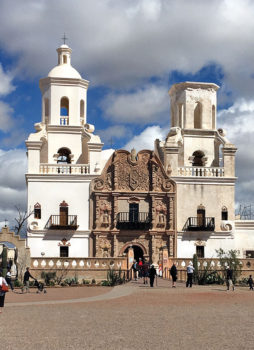
San Xavier del Bac Mission
Linda Shannon-Hills
Thursday Talks welcomes back Docent Craig Reid to discuss The Symbology of San Xavier del Bac Mission with Clague Van Slyke discussing the Restoration Process on Thursday, November 15 at 4:00 p.m. in La Mesa and Montana Rooms.
At San Xavier, symbols adorn the walls of the mission that come from O’odham, Spanish and Franciscan people who built this church. Some of the Spanish symbols are political and not religious. Symbols that we thought were somewhat modern may have roots back to the first peoples that came into the Sonoran Desert centuries before.
The most attractive is a symbol of a borderland where cultures come together to create something new and a place that fits into its desert setting like the saguaros on the hill above it.
Docent Clague Van Slyke will talk about restoration efforts including several current projects underway at San Xavier. Keeping up with restoration needs is a constant focus at San Xavier. Current projects have shown some exciting results. See some of restored art and work on updating the museum spaces and displays.
Kino founded the first mission at what would become San Xavier del Bac in 1692, the same year the Puritans in Salem, Mass., were busy executing people for witchcraft. San Xavier was named for St. Francis Xavier, one of the founders of the Jesuit order.
Construction of the existing church began in 1783 and was finished in 1797. Its Spanish Colonial architecture was designed by Ignacio Gaona, and it was built by O’odham workers. Its intricate, colorful interior decoration was created by unknown artisans.
Step inside into a riot of brilliant color that covers almost every inch, walls and ceilings bursting with statues and paintings of saints and angels. Most were created by those nameless native workers who built the church almost three centuries ago, but one much more recent addition is a wood carving of St. Kateri Tekakwitha, a Mohawk woman who in 2012 became the first Native American to be named a saint.
Although San Xavier is a Catholic Church, it incorporates elements of traditional Tohono O’odham culture. One walled courtyard has a metal gate depicting the Man in the Maze, another name for I’itoi, the O’odham’s mischievous creator god, who lives in a cave beneath Baboquivari Peak, a mountain about 50 miles to the southwest.
Join us on Thursday, November 15 at 4:00 p.m. to learn more about one of Tucson’s prized landmarks, the White Dove.
